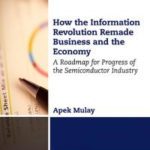I authored my first book “Mass Capitalism : A Blueprint for Economic Revival” in 2014 with a purpose of letting the global semiconductor industry ( and particularly the US Semiconductor Industry) know that the Semiconductor Industry is headed for a monumental transformation in the very near future due to a global macroeconomic crisis. Having a solid knowledge of macroeconomics alongwith a decade long career in US semiconductor industry working on state-of-the-art tools and technologies, I could foresee what most industry analysts and veterans could not foresee it coming.
I recently made a HAT-TRICK with my three consecutive LinkedIn blogs making it to LinkedIn PULSE in the categories both Technology and Economics. However, In this blog – I dare to raise an alarm for the global semiconductor industry which is headed in a wrong direction leading to huge problems for the industry at large. Today, We are seeing increasing consolidation happen in this industry and formation of business monopolies through elimination of competition. A healthy competition is essential for preserving innovation and by getting rid of the innovation, our progress of semiconductor industry is truly questionable and so is the progress of our knowledge based economy.
Many Industry experts talk about the next big thing as Internet of Things (IoT) which would lead to an exponential growth of devices so much that it would surpass the combined growth achieved with both computer and mobile revolution. However, I am of the opinion that this exponential growth of IoT market cannot happen in this climate of industry monopolies. For IoT revolution to succeed, there has to be a true free market economy, a robust growth of small businesses and steady growth in consumer purchasing power of citizens in the economy.
A debt-based economy is absolutely unsustainable and global macroeconomic crisis since 2008 has made this evident to even a person who has no background in macroeconomics. Hence, whether it is for letting the IoT revolution to happen, 450 mm wafer transition to occur, Moore’s law to progress beyond 10 nm or for recovery of global semiconductor industry at large, a good macroeconomic policy and a good monetary policy is an absolute must. So, Which Industrial model will bring about this IoT revolution – Will it be the Fabless-Foundry business model or the Integrated Device Manufacturers (IDMs)? The answer is neither and I have explained a failure of both models from a macroeconomic perspective in my first book released in 2014 “Mass Capitalism : A Blueprint for Economic Revival“, where I also put forth a third business model which is neo-fabless but it is sustainable from a macroeconomic perspective.
Debating between existing Fabless-Foundry business model and IDM business model is equivalent to debating between which economic system is better Crony Capitalism or Communism. Neither of the two economic systems have been able to solve the problems of semiconductor industry and global economy. The solution to global economy is true free market economy. Mass Capitalism is one such true free market economic system. Please do read this blog to understand the difference between Mass Capitalism, Crony Capitalism and Communism.
In my recently published article, ‘Intel is in trouble…but so are TSMC and Samsung‘, I mentioned that not only the IDMs are making cost cuts but even the foundries catering to Fabless semiconductor companies seem to be in trouble. The later has become evident in the article published in Forbes ‘Qualcomm Is Breaking Up, Already’, where it has become obvious that even the largest fabless semiconductor company in the world is facing a massive layoffs and will not be able to continue to sustain a progress of Moore’s Law. This is due to violations of common sense macroeconomics by Fabless semiconductor businesses worldwide.
In my proposed new neo-fabless business model which leads to a sustainable macroeconomy, all defects of existing fabless-foundry business model have been rectified which have resulted in trade and budget deficits. Additionally, the power of existing fabless-foundry business model to be able to usher in a growth of small businesses has been preserved. I have explained in my upcoming book published by Morgan & Claypool publishers entitled ‘Sustaining Moore’s Law: Uncertainty Leading to a Certainty of IoT Revolution‘, how this new business model for semiconductor industry would bring about the next big thing which is the IoT Revolution.
The foreword for my second book is by world renowned Professor of Economics and author of six International best sellers, Professor Ravi Batra. In his foreword, Professor Batra mentions,
“To my knowledge, Mr. Mulay is the only writer who has made a connection between Moore’s Law and macroeconomic policy. The Law has played a significant role in the vast computer revolution, but the author argues that without proper economic policies the future validity of this law is at best uncertain. Mr. Mulay’s contribution to the economic and technological literature is both monumental and practical. It is an innovative approach that deserves further study and research. It will appeal to those looking for new ideas.”
I hope global semiconductor industry will take these ideas and help bring about the next big thing of IoT revolution. The sustainability and profitability of this new business model would be useful for every developed economy such as USA, Germany, France, etc. Additionally, It would also help Chinese economy transition to its much need economy based on Innovation. At the same time, my first book “Mass Capitalism : A Blueprint for Economic Revival” would act as a blueprint for developing economies like India and its prime minister’s signature “Make in India” campaign for creating manufacturing jobs in India and the second book ‘Sustaining Moore’s Law: Uncertainty Leading to a Certainty of IoT Revolution‘ would act as a blueprint for Prime Minister, Narendra Modi’s Digital India Campaign.


Recent Comments